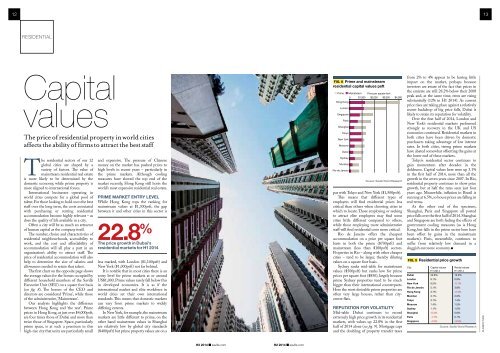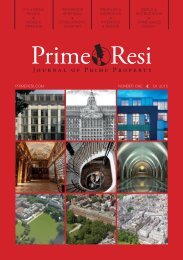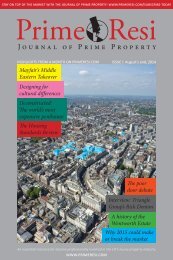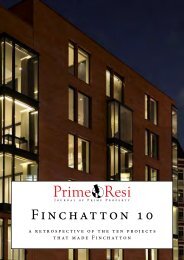Savills 12 Cities Report
Live/Work Index
Live/Work Index
You also want an ePaper? Increase the reach of your titles
YUMPU automatically turns print PDFs into web optimized ePapers that Google loves.
<strong>12</strong><br />
13<br />
residential<br />
Capital<br />
values<br />
The price of residential property in world cities<br />
affects the ability of firms to attract the best staff<br />
The residential sectors of our <strong>12</strong><br />
global cities are shaped by a<br />
variety of factors. The value of<br />
mainstream residential real estate<br />
is more likely to be determined by the<br />
domestic economy, while prime property is<br />
more aligned to international forces.<br />
International businesses operating in<br />
world cities compete for a global pool of<br />
talent. For those looking to hold on to the best<br />
staff over the long term, the costs associated<br />
with purchasing or renting residential<br />
accommodation become highly relevant – as<br />
does the quality of life available in a city.<br />
Often a city will be as much an attractor<br />
of human capital as the company itself.<br />
The number, choice and characteristics of<br />
residential neighbourhoods, accessibility to<br />
work, and the cost and affordability of<br />
accommodation will all play a part in an<br />
organisation’s ability to attract staff. The<br />
price of residential accommodation will also<br />
help to determine the size of salaries and<br />
allowances needed to retain that talent.<br />
The first chart on the opposite page shows<br />
the average values for the homes occupied by<br />
different household members of the <strong>Savills</strong><br />
Executive Unit (SEU) on a square foot basis<br />
(see fig. 8). The homes of the CEO and<br />
directors are considered ‘Prime’, while those<br />
of the administrative, ‘Mainstream’.<br />
Our analysis highlights the difference<br />
between Hong Kong and ‘the rest’. Prime<br />
prices in Hong Kong, at just over $4,000psft,<br />
are four times those of Dubai and more than<br />
twice those of Singapore. Space, particularly<br />
prime space, is at such a premium in this<br />
high-rise city that units are particularly small<br />
and expensive. The pressure of Chinese<br />
money on the market has pushed prices to<br />
high levels in recent years – particularly in<br />
the prime markets. Although cooling<br />
measures have slowed the top end of the<br />
market recently, Hong Kong still hosts the<br />
world’s most expensive residential real estate.<br />
prime market entry level<br />
While Hong Kong tops the ranking for<br />
mainstream values at $1,300psft, the gap<br />
between it and other cities in this sector is<br />
22.8 %<br />
The price growth in Dubai’s<br />
residential markets for H1 2014<br />
less marked, with London ($1,100psft) and<br />
New York ($1,000psft) not far behind.<br />
It is notable that in most cities there is an<br />
entry level for prime markets at or around<br />
US$1,000. Prime values rarely fall below this<br />
in developed economies. It is as if the<br />
international market and elite workforce in<br />
world cities set their own international<br />
standards. This means that domestic markets<br />
can vary from prime markets to widely<br />
differing extents.<br />
In New York, for example, the mainstream<br />
markets are little different to prime, on the<br />
other hand mainstream values in Shanghai<br />
are relatively low by global city standards<br />
($400psft) but prime property values are on a<br />
Fig. 8 Prime and mainstream<br />
residential capital values psft<br />
Prime Mainstream Price per square foot<br />
0 $1,000 $2,000 $3,000<br />
Hong Kong<br />
London<br />
Singapore<br />
Paris<br />
Shanghai<br />
Tokyo<br />
New York<br />
Moscow<br />
Dubai<br />
Sydney<br />
Mumbai<br />
Rio de Janeiro<br />
$4,000<br />
Source: <strong>Savills</strong> World Research<br />
par with Tokyo and New York ($1,500psft).<br />
This means that different types of<br />
employers will find residential prices less<br />
critical than others when choosing cities in<br />
which to locate. Those employing or seeking<br />
to attract elite employees may find some<br />
cities little different compared to others,<br />
while those employing more administrative<br />
staff will find residential costs more critical.<br />
Rio de Janeiro offers the cheapest<br />
accommodation on a price per square foot<br />
basis in both the prime ($700psft) and<br />
mainstream (less than $100psft) sectors.<br />
Properties in Rio – along with other cheaper<br />
cities – tend to be larger, thereby diluting<br />
values on a square foot basis.<br />
Sydney ranks mid-table for mainstream<br />
values ($500psft) but ranks low for prime<br />
prices per square foot ($850), largely because<br />
prime Sydney properties tend to be much<br />
bigger than their international counterparts.<br />
Here the most desirable prime properties are<br />
often very large houses, rather than citycentre<br />
flats.<br />
reputation for volatility<br />
Mid-table Dubai continues to record<br />
extremely high price growth in its residential<br />
markets, with values up 22.8% in the first<br />
half of 2014 alone (see fig. 9). Mortgage caps<br />
and the doubling of property transfer taxes<br />
from 2% to 4% appear to be having little<br />
impact on the market, perhaps because<br />
investors are aware of the fact that prices in<br />
the emirate are still 28.2% below their 2008<br />
peak and, at the same time, rents are rising<br />
substantially (<strong>12</strong>% in H1 2014). As current<br />
price rises are taking place against a relatively<br />
recent backdrop of big price falls, Dubai is<br />
likely to retain its reputation for volatility.<br />
Over the first half of 2014, London and<br />
New York’s residential markets performed<br />
strongly as recovery in the UK and US<br />
economies continued. Residential markets in<br />
both cities have been driven by domestic<br />
purchasers taking advantage of low interest<br />
rates. In both cities, strong prime markets<br />
have abated somewhat offsetting the gains at<br />
the lower end of these markets.<br />
Tokyo’s residential sector continues to<br />
gain momentum after decades in the<br />
doldrums. Capital values here were up 3.1%<br />
in the first half of 2014, more than all the<br />
growth in the seven years since 2007. In Rio,<br />
residential property continues to show price<br />
growth, but at half the rates seen just four<br />
years ago. Meanwhile, inflation in Brazil is<br />
running at 6.5%, so house prices are falling in<br />
real terms.<br />
At the other end of the spectrum,<br />
Shanghai, Paris and Singapore all posted<br />
price falls over the first half of 2014. Shanghai<br />
and Singapore are both feeling the effects of<br />
government cooling measures (as is Hong<br />
Kong, but falls in the prime sector here have<br />
been offset by gains in the mainstream<br />
markets). Paris, meanwhile, continues to<br />
suffer from relatively low demand in a<br />
sluggish eurozone economy.<br />
Fig. 9 Residential price growth<br />
City capital values Rental values<br />
H1 2014 H1 2014<br />
Dubai 22.8% <strong>12</strong>.0%<br />
London 9.1% 0.9%<br />
New York 6.5% -0.1%<br />
Rio de Janeiro 5.1% 3.8%<br />
Hong Kong 3.7% -2.4%<br />
Mumbai 3.1% 2.0%<br />
Tokyo 3.1% 1.4%<br />
Moscow 1.4% 1.5%<br />
Sydney 1.1% 1.0%<br />
Shanghai -0.4% 0.6%<br />
Paris -1.7% 0.1%<br />
Singapore -4.2% -3.5%<br />
Source: <strong>Savills</strong> World Research<br />
Plainpicture<br />
H2 2014<br />
savills.com<br />
H2 2014<br />
savills.com







